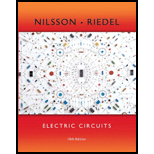
Concept explainers
a.
Calculate the value of capacitance
b.
Calculate the value of capacitance and the roots of the characteristic equation when the capacitance is adjusted to give a neper frequency of
c.
Calculate the value of capacitance and the roots of the characteristic equation when the capacitance is adjusted to give a resonant frequency of
Learn your wayIncludes step-by-step video

Chapter 8 Solutions
Electric Circuits (10th Edition)
Additional Engineering Textbook Solutions
Starting Out with C++: Early Objects (9th Edition)
Java: An Introduction to Problem Solving and Programming (8th Edition)
Mechanics of Materials (10th Edition)
Degarmo's Materials And Processes In Manufacturing
Management Information Systems: Managing The Digital Firm (16th Edition)
INTERNATIONAL EDITION---Engineering Mechanics: Statics, 14th edition (SI unit)
- JOB UPDATE Apply on- Jobswood.com OR Search "Jobswood.com" on Google COMPANY JOB PROFILE JOB LOCATION WEB ENGINEER GOOGLE MULTIPLE CITIES (FRESHERS) AMAZON SOFTWARE DEV ENGG MULTIPLE CITIES COGNIZANT SYSTEMS ENGINEER CHENNAI ZENSAR FRONTEND DEVELOPER BENGALURU ORACLE AUTOMATION ENGINEER BENGALURU DIGITAL OCEAN SUPPORT ENGINEER HYDERABAD IBM APPLICATION DEVELOPER HYDERABAD INDIAMART WORK FROM HOME MULTIPLE CITIES AMAZON RECRUITER HYDERABAD GE HEALTHCARE TRAINEE ENGINEER BENGALURUarrow_forwardJOB UPDATE Apply on Vinkjobs.com OR Search "VinkJobs.com" on Google Company Name Job Profile Job Location CISCO Software Engineer Bengaluru Accenture Associate (Freshers) Chennai Trellix Developer Bengaluru Verizon SDET Bengaluru Allerin Test Engineer Mumbai Sutherland SQL/.Net Developer Chennai Bottomline DevOps Engineer Multiple Cities IQVIA HRIS Specialist Bengaluru BYJU's Associate Multiple Cities Spring Works Executive WFH (Remote)arrow_forwardDon't use ai to answer I will report you answerarrow_forward
 Introductory Circuit Analysis (13th Edition)Electrical EngineeringISBN:9780133923605Author:Robert L. BoylestadPublisher:PEARSON
Introductory Circuit Analysis (13th Edition)Electrical EngineeringISBN:9780133923605Author:Robert L. BoylestadPublisher:PEARSON Delmar's Standard Textbook Of ElectricityElectrical EngineeringISBN:9781337900348Author:Stephen L. HermanPublisher:Cengage Learning
Delmar's Standard Textbook Of ElectricityElectrical EngineeringISBN:9781337900348Author:Stephen L. HermanPublisher:Cengage Learning Programmable Logic ControllersElectrical EngineeringISBN:9780073373843Author:Frank D. PetruzellaPublisher:McGraw-Hill Education
Programmable Logic ControllersElectrical EngineeringISBN:9780073373843Author:Frank D. PetruzellaPublisher:McGraw-Hill Education Fundamentals of Electric CircuitsElectrical EngineeringISBN:9780078028229Author:Charles K Alexander, Matthew SadikuPublisher:McGraw-Hill Education
Fundamentals of Electric CircuitsElectrical EngineeringISBN:9780078028229Author:Charles K Alexander, Matthew SadikuPublisher:McGraw-Hill Education Electric Circuits. (11th Edition)Electrical EngineeringISBN:9780134746968Author:James W. Nilsson, Susan RiedelPublisher:PEARSON
Electric Circuits. (11th Edition)Electrical EngineeringISBN:9780134746968Author:James W. Nilsson, Susan RiedelPublisher:PEARSON Engineering ElectromagneticsElectrical EngineeringISBN:9780078028151Author:Hayt, William H. (william Hart), Jr, BUCK, John A.Publisher:Mcgraw-hill Education,
Engineering ElectromagneticsElectrical EngineeringISBN:9780078028151Author:Hayt, William H. (william Hart), Jr, BUCK, John A.Publisher:Mcgraw-hill Education,





